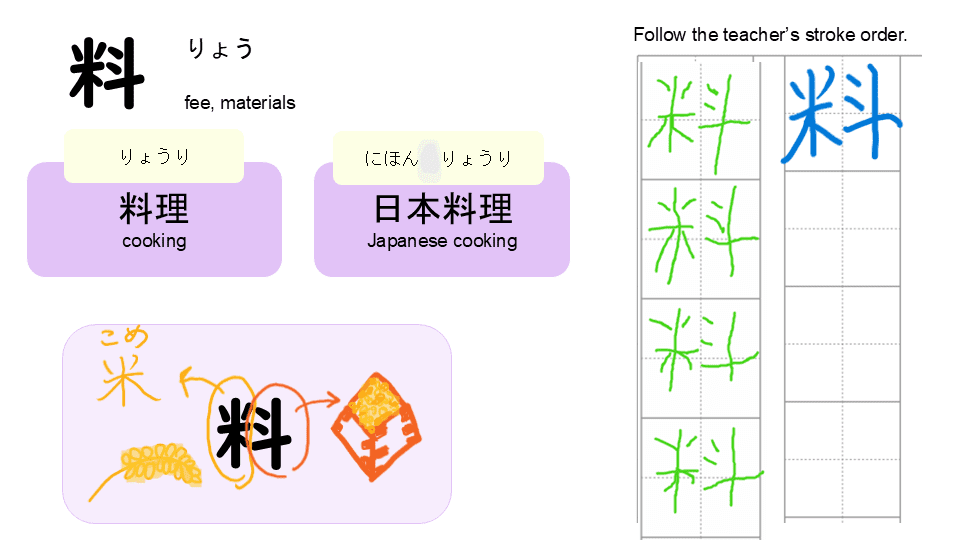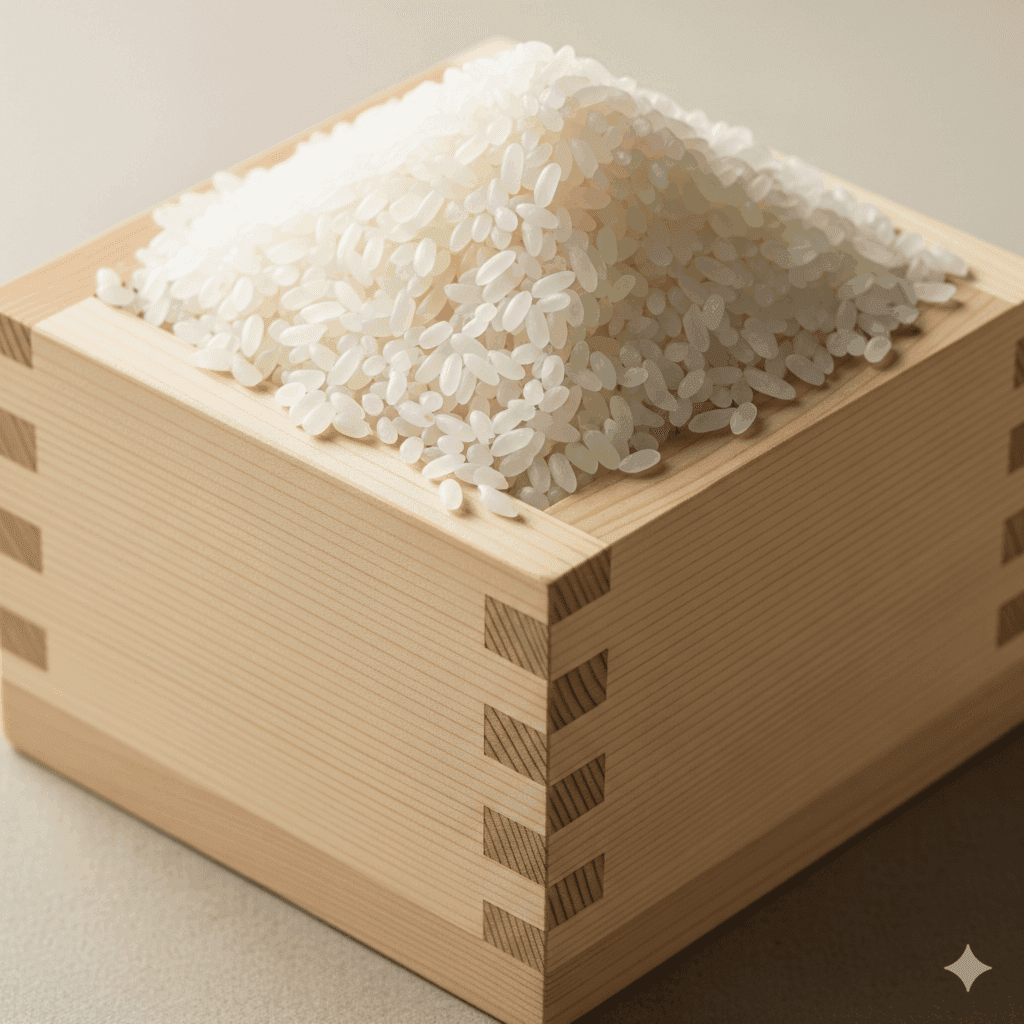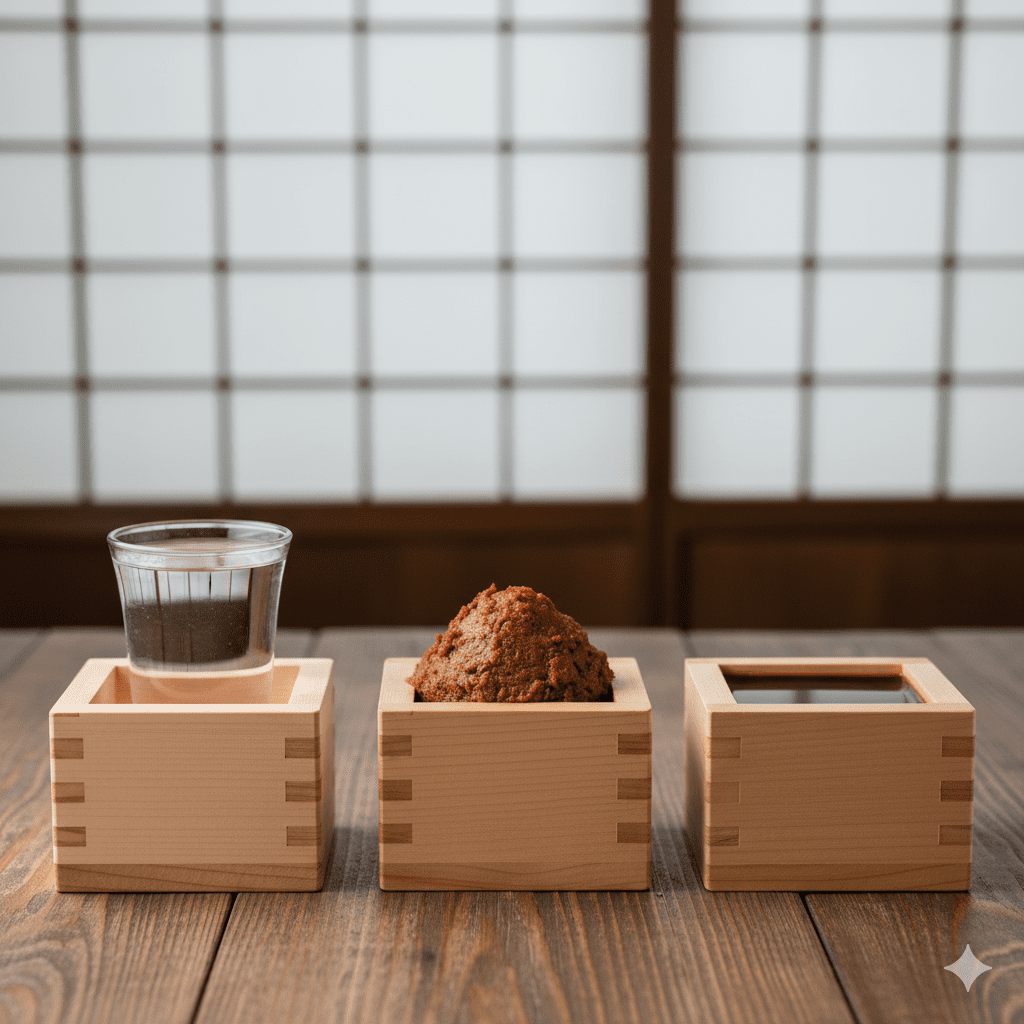Old Japanese Units Explained: Masu, Go, To, Koku |合・升・斗・石でわかる日本の昔の単位
升(ます)って何?日本の古い単位を学ぼう
What Is a “Masu”? A Look into Old Japanese Units
先日、漢字の授業で「料理」という漢字の成り立ちについてお話ししました。
「料」という字が、お米と、お米が入った升の形からできていると説明したところ、

「升って、なんですか?」
今日は、この素晴らしい質問に答えながら、日本の昔の単位について一緒に見ていきましょう。
In a recent kanji lesson, I explained how the kanji for “ryōri” (料理), which means “cooking” or “cuisine,” was formed. I mentioned that the character for “ryō” (料) is made up of a symbol for “rice” and an image of a masu (升), a box filled with rice. A great question came from one of my students:
“What’s a masu?”
Today, let’s answer that question and explore the old units of measurement used in Japan.
「升」って、どんなもの?What Is a “Masu”?
升は、昔の日本で米や酒を量るために使われていた、四角い木製の箱のことです。
A masu (升) is a traditional wooden box used in old Japan to measure rice and sake (Japanese rice wine).

この 箱 は
単 なる
道具 ではなく、その
容量 がそのまま
単位 として
使 われるようになりました。
容量 は
1 升 が
約
1.8リットル(L)(やく1.9クォート/qt)、つまり
2Lのペットボトルとほぼ
同 じくらいの
量 です。
While it was just a container, its capacity became a standard unit of measurement. The capacity of one shō (升) is approximately 1.8 liters (L) (about 1.9 quarts/qt). To give you a modern example, that’s roughly the size of a large water bottle.
なぜ日本で「升」が単位になったの?
Why Did the “Masu” Become a Unit of Measurement?
升が重要な単位へと発展した背景には、日本の文化や社会の仕組みが深く関わっています。
-
お米が「お金」だった時代
江戸時代より前の日本では、お米が通貨のような役割を果たしていました。農民はお米で税金を納め、武士はお米で給料をもらっていたのです。そのため、お米の量を正確に測る単位が不可欠でした。 -
生活に根ざした「シンプルな」単位
「10合で1升、10升で1斗、10斗で1石」というように、10倍ずつで次の単位になるシンプルな仕組みは、生活や商取引でとても便利でした。お米だけでなく、お酒や味噌、醤油なども「升」や「合」で量を測ることができたのです。

The reason the masu became an important unit is closely tied to the country’s culture and economic system.
-
Rice Was the Center of Life and Economy
In Japan before the Edo period, rice was a form of currency. Farmers paid their taxes with rice, and samurai were paid their salaries in rice. Because of this, an accurate unit for measuring rice was essential. -
Simple Units Rooted in Daily Life
The system was simple and easy to remember: **10 gō = 1 shō, 10 shō = 1 to, 10 to = 1 koku.** This tiered system made measuring things for daily life and business simple. Not only rice and sake, but also things like miso, soy sauce, and oil were measured with these units. The units weren’t just for measurement; they were part of the rhythm of daily life.
| 単位 | 旧来の量 | 現代の容量 | 米国換算 | イメージ |
|---|---|---|---|---|
| 合 | 1合 | 約180 ml | about 6 fl oz |
ごはん一杯分
|
| 升 | 10合 | 約1.8 L | about 1.9 qt |
ペットボトル1本分
|
| 斗 | 10升 | 約18 L | about 4.8 gal |
大きなバケツ1杯分 |
| 石 | 10斗 | 約180 L | about 47.5 gal |
1人が1年間に食べるお米の量 |
| Unit | Old Quantity | Modern Measure | U.S. Measure | Image |
|---|---|---|---|---|
| Gō (合) | 1 Gō | approx. 180 ml | about 6 fl oz |
A small bowl of rice
|
| Shō (升) | 10 Gō | approx. 1.8 L | about 1.9 qt |
A 2-liter bottle
|
| To (斗) | 10 Shō | approx. 18 L | about 4.8 gal |
A large bucket |
| Koku (石) | 10 To | approx. 180 L | about 47.5 gal |
The amount of rice one person eats in a year |
📖 Japanese Volume Units — Flashcards📖
Click a card to flip it!
Gō
About 6 fl oz

Shō
About 1.9 qt

To
About 4.8 gal
Koku
About 47.5 gal
漢字の
成り
立ちから
始まったひとつの
質問が、
日本の
奥深い
文化を
知るきっかけになるなんて、
面白いですよね!
あなたもぜひ Niko Niko Japanese で、
興味のあることを
先生に質問してみませんか?
漢字の授業は、成り立ちから知ることができたり、
書き順まで正しく学ぶことができ、とても人気があります。
まずはトライアルレッスンで、日本語を楽しく体験してみてください!
It’s fascinating how a single question about a kanji can lead to a deeper understanding of Japanese culture!
At Niko Niko Japanese, you can also ask your own questions
and discover the fun of learning.
Our kanji lessons are especially popular — you can explore the origins of characters,
practice the correct stroke order, and build a strong foundation.
Try a trial lesson and experience Japanese in a fun way!
✏️ 書いた漢字を先生に見てもらおう! Show Your Kanji Writing to the Teacher!
あなたは漢字が好きですか?それとも苦手ですか?
漢字の成立ちを知ると、効率よく覚えられ、忘れにくくなります。
また、漢字を通して日本の文化を感じることもでき、学びがさらに深まります。
「この漢字ってどんな意味だろう?」といった好奇心を聞くことが、私はとても嬉しいです。
ぜひ、一度トライアルレッスンで一緒にお話ししてみましょう。
保護者の方からのご相談も大歓迎です。子供が漢字を覚えにくい、勉強に興味が持てないなど、どんなことでもご相談ください。😊
Do you like kanji, or find it difficult?
Learning the origins of kanji helps you memorize them efficiently and makes them hard to forget.
Through kanji, you can also feel Japanese culture more deeply.
I love hearing your curiosity, like “What does this kanji mean?”
Let’s talk about it together in a trial lesson!
Parents are also welcome to consult me if your child struggles with kanji or studying. Anything is okay to ask. 😊
「希望した日がすでに授業でいっぱい…」というときは、
👉 お問い合わせフォーム からご連絡ください。
If your preferred date is already fully booked,
👉 please contact us through the Contact Form.
